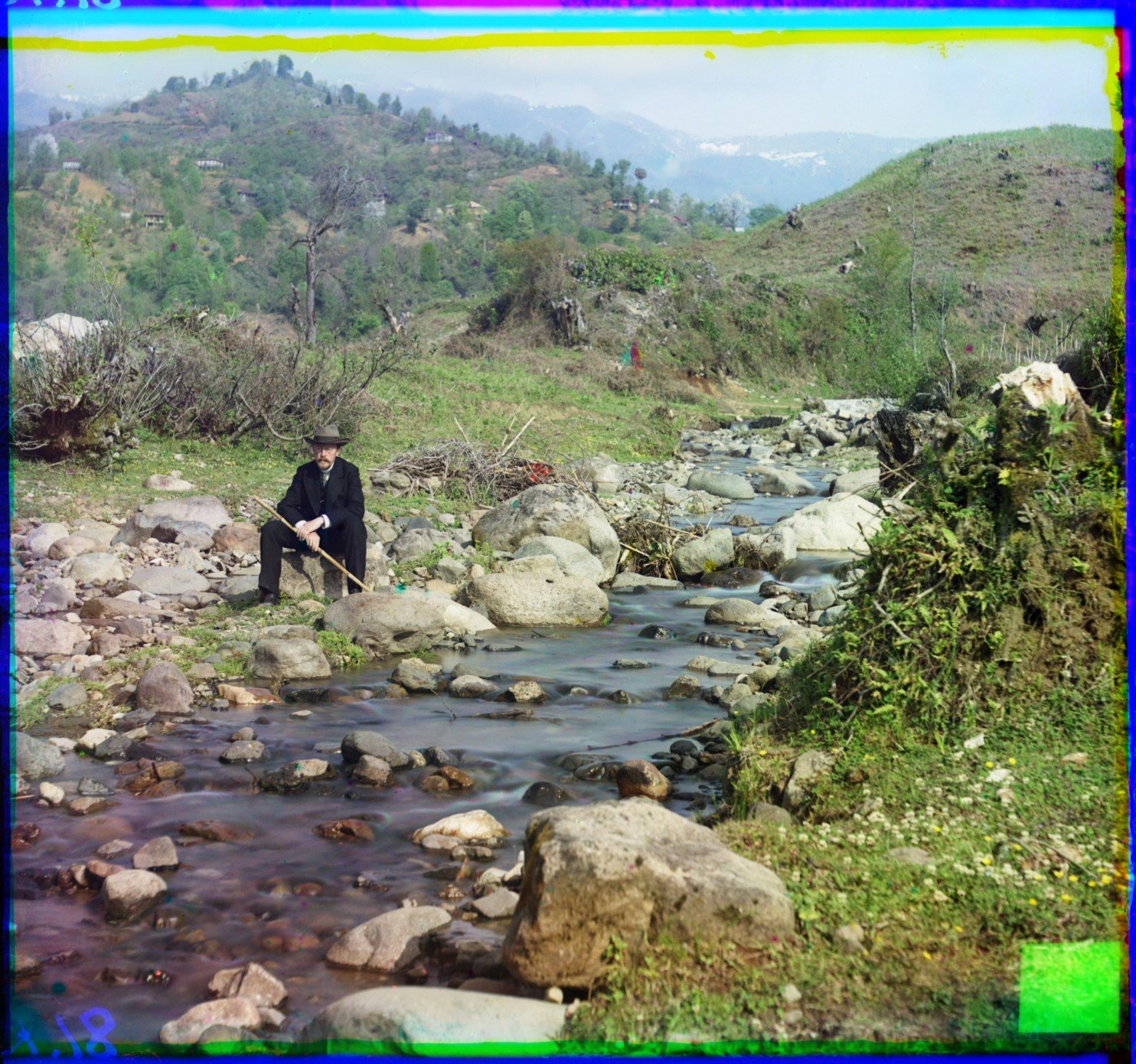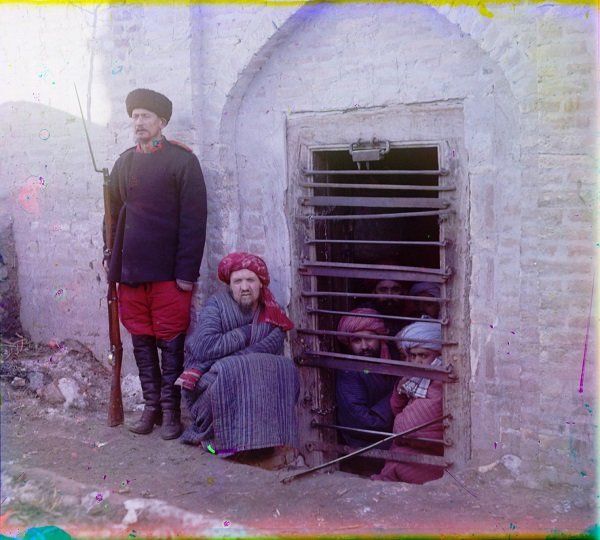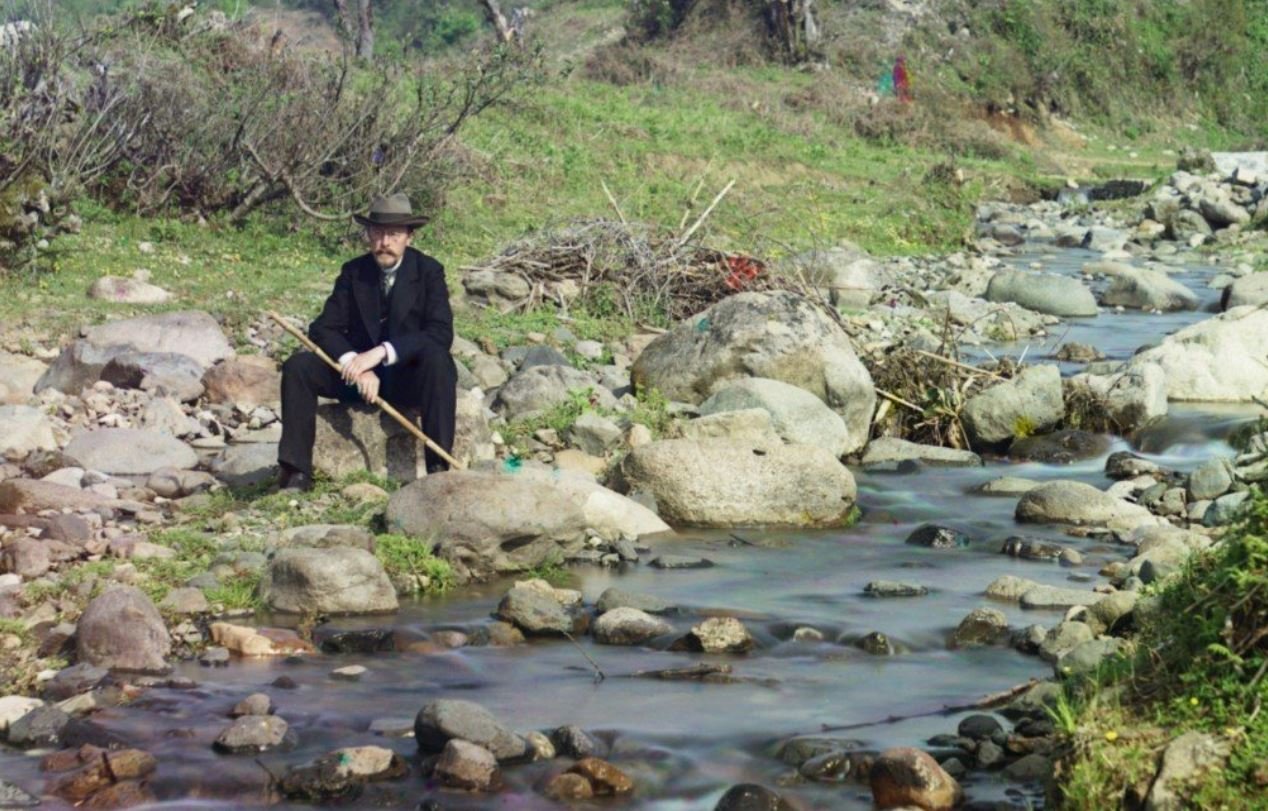
© Library of CongressSergei Mikhailovich Prokudin-Gorskii sits beside the Karolitskhali River. (1912)
Sergei Mikhailovich Prokudin-Gorskii was born near Moscow in 1863. Educated as a chemist, Prokudin-Gorskii applied his knowledge and skills towards the advancement of photography. He was especially interested in the reproduction of color, which at the time was a tedious and difficult process.
Though some of his images date back to 1905, the bulk of his work documenting the Russian empire of Tsar Nicholas II took place between 1909-1915. Prokudin-Gorskii's color photos were recorded as "separation negatives" on black and white glass plates. The camera he used made three sequential exposures through blue, green and red filters. He then printed these negatives as positives, which he inserted into a magic lantern to project and superimpose the frames back through the same combination of filters. The result was a full color reproduction of the original scene.

© Library of CongressCatholic Armenian women in customary dress. (between 1905 and 1915)

© Library of CongresPinkhus Karlinskii. 84, supervisor of the Chernigov floodgate, with 66 years of service. (1909)
The bulk of this project took place from 1909 to 1915, when Prokudin-Gorskii traveled about the land in a railroad car outfitted as a darkroom, provided to him by the tsar.
In the composite image below, I used Adobe Photoshop to recreate the process of converting three black and white frames into a full color image.

© Library of CongressThree young women offer berries to visitors to their izba, a traditional wooden house, in a rural area along the Sheksna River, near the town of Kirillov. (1909)
In the black and white strip on the left, the filter sequence is blue, green and red.
First, I created a blank RGB (red/green/blue) file in Photoshop that was the size and resolution of one of the individual frames. I then copied each of the frames into the corresponding color channel of the Photoshop file. A simple lining up of the channels resulted in the full color image on the right.
Ghosting in Prokudin-Gorskii's color images is caused by any misalignment between the successive exposures. Probable reasons for this are subject movement and/or movement of the negative plate between the exposures.

© Library of CongressStudies on Lindozero. The breed of dog is a Laika. (1915)
![Click to enlarge Wooden Church of the Transfiguration of Our Lord. The village of Pidma. [Russian Empire] (1909)](/image/s15/315051/imrs_php.jpg)
© Library of CongressWooden Church of the Transfiguration of Our Lord. The village of Pidma. [Russian Empire] (1909)

© Library of CongressJewish children with a teacher. Samarkand. (between 1905 and 1915)

© Library of CongressGirl with strawberries. (1909)
![Click to enlarge Armenian women in holiday attire. [Artvin] (between 1905 and 1915)](/image/s15/315055/imrs_php.jpg)
© Library of CongressArmenian women in holiday attire. [Artvin] (between 1905 and 1915)

© Library of CongressKush-Beggi, Minister of the Interior, Bukhara. (between 1905 and 1915)

© Library of CongressThree generations. A.P. Kalganov with son and granddaughter, who work in the shops of the Zlatoust arms plant. (1910)

© Library of CongressZindan prison, with inmates looking out through the bars and a guard with Russian rifle, uniform, and boots, Central Asia. (between 1905 and 1915)

© Library of CongressRailroad construction on the Shadrinsk-Sinara railroad near the city of Shadrinsk. (1912)

© Library of CongressA switch operator poses on the Trans-Siberian Railroad near the town of Ust Katav on the Yuryuzan River. (1910)

© Library of CongressMan in uniform beside building, yurt in background. (between 1905 and 1915)

© Library of CongressIsfandiyar, Khan of the Russian protectorate of Khorezm (Khiva). (between 1910 and 1915)
Prokudin-Gorskii left Russia in 1918 after the revolution. He eventually settled in Paris, where he died in 1944. The Library of Congress purchased the collection from his sons in 1948.
The
Sergei Mikhailovich Prokudin-Gorskii collection of the Library of Congress has 1,902 of these black and white glass triple-frame plates, as well as several thousand sepia toned and color prints.
Digital color composites for these images were made for the Library of Congress by Blaise Agüera y Arcas in 2004. Images are courtesy of the Library of Congress.
More information on Sergei Mikhailovich Prokudin-Gorskii, as well as a larger selection of his images can be found at the
Library of Congress.



![Click to enlarge Wooden Church of the Transfiguration of Our Lord. The village of Pidma. [Russian Empire] (1909)](/image/s15/315051/imrs_php.jpg)









![Click to enlarge Armenian women in holiday attire. [Artvin] (between 1905 and 1915)](/image/s15/315055/imrs_php.jpg)






[Link]